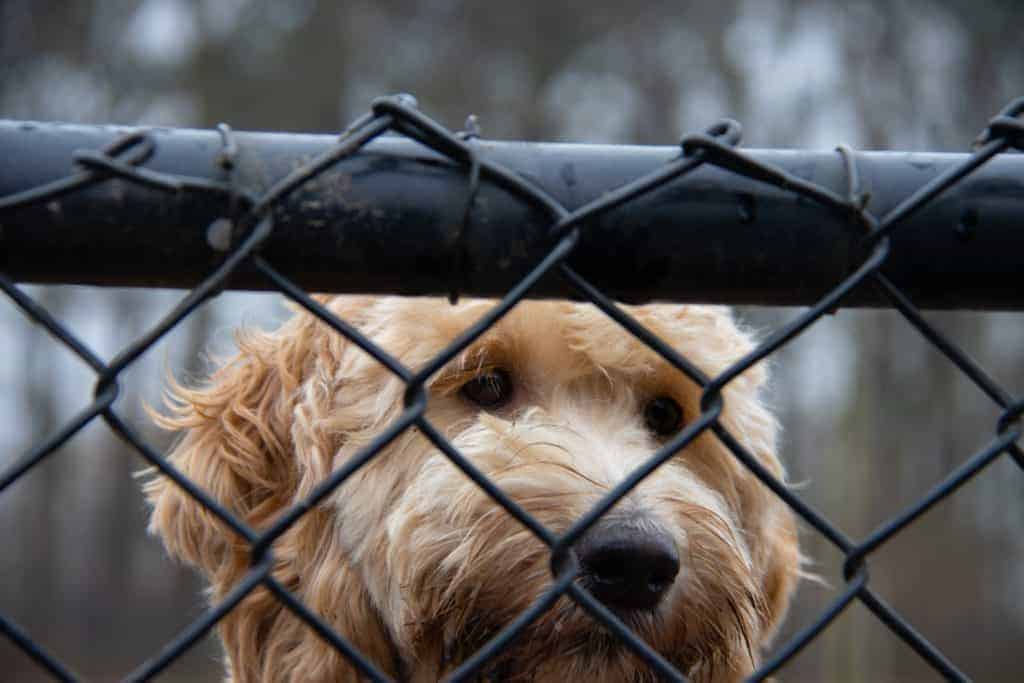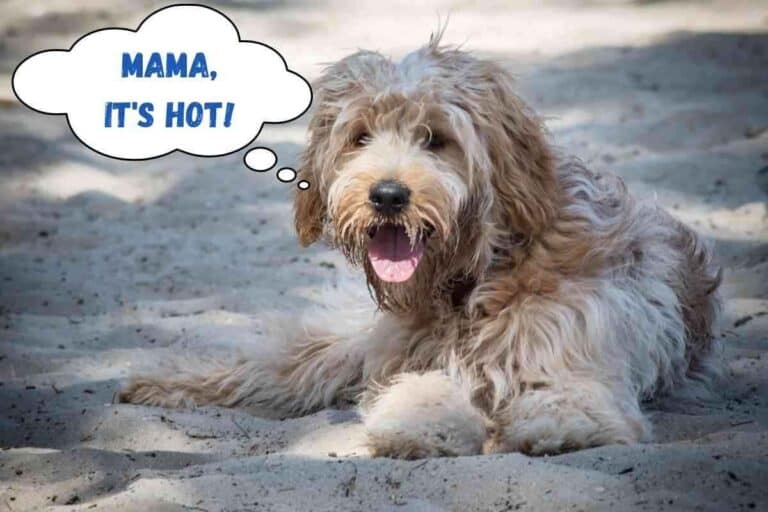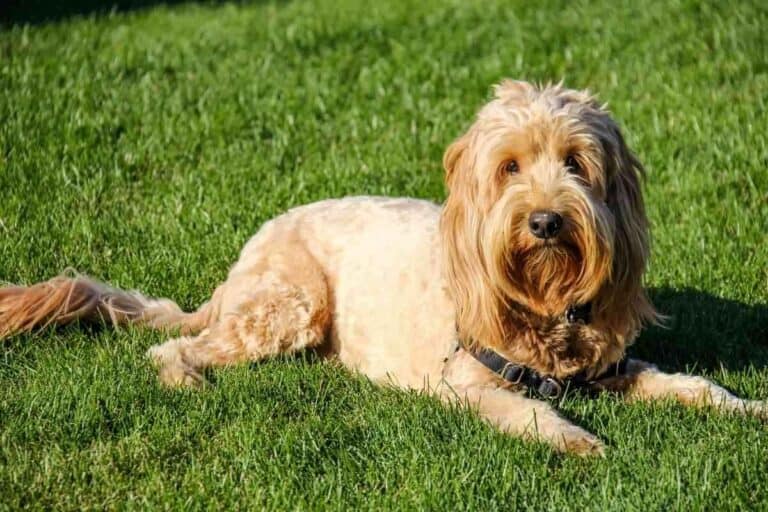Why Is My Goldendoodle Shedding? (Key Factors)
Goldendoodles are a lovable cross-breed, and they are lovely to snuggle with, even for people with pet allergies, but not all Goldendoodles are hypoallergenic. Some shed as much as a Golden Retriever does. Others shed minimal amounts. The amount of shedding depends on several things.
Wondering why your Goldendoodle is shedding?
Your Goldendoodle is shedding because of the genes passed on from the Golden Retriever in its ancestry. They have three coat types: straight, wavy, and curly. Straight coats shed the most and resemble a Golden Retrievers coat. Wavy coats look like a mixture of both and shed a small amount. Curly coats don’t shed at all. The generation of Goldendoodle affects whether or not it sheds.
Get Your Goldendoodle DNA Tested
The most accurate way to tell is through a Goldendoodle DNA test. DNA tests can indicate the type of coat a dog will produce.
They can isolate straight coat genes and curly coat genes. I recommend you get a DNA test if you want to be sure.
DNA tests are usually correct, with the amount of science and research that goes into it, but they are never 100% accurate.
Three Kinds Of Coats
Many people don’t realize how many types of Goldendoodles there are.
They are all similar in temperament and are just as loveable, but some have more desirable features. Lots of people that get Goldendoodles try to get one that will be hypoallergenic if they are sensitive to pets.
Others like the soft, luscious hair that certain generations produce. It’s a sought-after look.
It’s essential to understand the differences between the generations and how it affects the type of coat the Goldendoodle will have. In this post, we will look at both, but let’s start with the coat differences.
Curly

Curly coats do not shed at all.
A Goldendoodle with this coat type won’t shed because they have entirely inherited their coats from the Poodle in their ancestry. Any hair loss that occurs is not natural.
Goldendoodles with a curly coat look the most like a Poodle and are the most hypoallergenic.
Their hair is very curly and kinky. They need to be brushed every day to prevent their hair from matting. They are high maintenance when it comes to grooming.
Owners who don’t have the time to brush every day sometimes get the entire coat shaved off with clippers. This makes it less maintenance for them and is acceptable, though it may not be the best look for the dog. I have to imagine there is nothing quite like taking a freshly shaved poodle for a walk.
Curly Goldendoodles don’t have as many facial furnishings. Sure, they might be able to sport a beard or a mustache, but their hair is too curly and short for it to compare to the Wavy coated Goldendoodles.
Wavy

These Goldendoodles usually don’t shed much, but they can shed.
The amount they will shed depends on who the parents were, and the genes passed onto them.
The wavy coat, teddy-bear coat, and shaggy coat are some of the names this type can be called. They are popular and highly sought out.
They have soft hair that can have a fluff to it. It’s the type of hair you can run your fingers through when it’s long. It has a curl to it but is wavy. It’s not entirely straight or curly.
Goldendoodles with this coat type are much easier to groom as their coats don’t mat as much as curly coats. Brushing once a week is totally acceptable. This coat type can shed, but it doesn’t usually shed a lot.
Wavy coated Goldendoodles have facial furnishings, like mustaches and beards, that make them stand out. Many people like this look. Their hair can grow up to 8 inches, which further adds to their appearance’s uniqueness.
Their coat is, usually, soft and plush. You can run your fingers through it. It’s more similar to human hair than dog hair. They are wonderful for snuggling!
Straight

Straight coats shed the most and are not hypoallergenic.
They shed the same amount a Golden Retriever sheds. These Goldendoodles have inherited their coats fully from a Golden Retriever in their ancestry.
Straight coats are the rarest out of the three. Goldendoodles with this coat type look the most like a Golden Retriever. Sometimes traits from the Poodle can be seen, but it’s often minimal.
They are a lot easier to groom and maintain than the other two coat types. Grooming once a week with a good shedding brush should do the job.
Straight coats are easier to spot because they don’t have as full of a face.
They have shorter hair and don’t have any facial furnishings as their hair is too short.
How to tell what type of coat a Goldendoodle will have
A few different things can help you figure out what type of Adult coat your Goldendoodle will grow into when his puppy coat sheds. The first thing you should determine is what type of generation your Goldendoodle is.
What Generation Is The Goldendoodle?
This is important to understand: Goldendoodles can be from one of four different types of generations.
Each generation has unique features. Knowing the generation can indicate what the coat type will be and if it will shed or not.
Here is a table for a quick way to understand the multi-generational breeding process and the likelihood of shedding. Most breeders use Poodles for backcross breeding to increase the likelihood of having hypoallergenic coats. This table reflects that.
| Parent One | Parent Two | Generation | Chances of Shedding | ||
| Purebred Poodle | + | Purebred Goldendoodle | = | F1 Goldendoodle | Likely |
| Purebred Poodle | + | F1 Goldendoodle | = | F1b Goldendoodle | Somewhat Likely |
| F1 Goldendoodle | + | F1 Goldendoodle | = | F2 Goldendoodle | Less Likely |
| F1 Goldendoodle | + | F2 Goldendoodle | = | F2b Goldendoodle | Less Likely |
| F2 Goldendoodle | + | F2 Goldendoodle | = | F3 Goldendoodle | More Likely |
| F3 Goldendoodle | + | F3 Goldendoodle | = | Multi-Generation | Less Likely |
What is an F1 Goldendoodle?
F1 Goldendoodles are first-generation and result from breeding a purebred Poodle with a purebred Golden Retriever.
F1’s are the most likely to shed because 50% of their genes come from the Golden Retriever parent. Their coat types vary. Statistically, 50% of the puppies produced will shed, but this is not always the case.
The grooming difficulty will vary depending on the coat produced.
It’s believed that F1’s receive extra health benefits due to a scientific phenomenon called “heterosis,” also known as “hybrid vigor.”
Cross-breeding creates an improved biological function and can decrease the likelihood of Goldendoodle having the health problems associated with their parent breeds.
What is an F1b Goldendoodle?
F1b Goldendoodles are the first-generation backcross. They result from breeding a first-generation (F1) Goldendoodle with a purebred Poodle.
Half of F1b Goldendoodles will shed to varying degrees. Some of the F1b’s will shed a minimal amount and be somewhat hypoallergenic. Some will shed close to the level of a Golden Retriever.
The coat types of this generation will vary, but if one of the parents is a purebred Poodle, the puppies have a higher chance of having a curly or wavy coat.
Remember, wavy coats can shed but not by much. Some F1b’s will have straight coats, but the chances of this occurring are less than in F1’s.
The grooming difficulty will vary on the coat produced.
F1b’s still benefit from hybrid vigor, but not as much since one of their parents is a purebred.
What is an F2 Goldendoodle?
F2 Goldendoodles are the second generation and result from breeding two first-generation (F1) Goldendoodles together.
They are more likely to shed than both F1’s and F1b’s.
This combination is not often used by breeders as there is a greater chance of the pups inheriting two copies of the shedding gene from the Golden Retriever DNA since both parents carry the gene.
This can produce puppies that will grow to shed more than a Golden Retriever.
F2’s are not recommended if you want a hypoallergenic dog unless your breeder has done genetic testing on the parents to make sure they don’t carry the shedding gene.
Here is what you can expect from the F2 Generation:
- 1/4th of F2’s will have nonshedding coats
- 1/2 of F2’s will shed a low to moderate amount
- 25% of F2’s will shed as much as a Golden Retriever
I know it seems like the opposite should occur: the further you get away from the Golden Retriever, the less they should shed, but that’s not how it works.
What is an F2b Goldendoodle?
F2b Goldendoodles are a second-generation backcross.
They result from breeding a first-generation (F1) Goldendoodle with a second-generation (F2) Golden-doodle.
F2b’s usually shed less than F2’s but predicting an F2b’s coat type is difficult without genetic testing. The odds of inheriting a straight coat (which sheds) depend on the parent’s genetics.
Usually, breeders don’t breed the Goldendoodles with this gene, but if no genetic testing was done, it’s guesswork.
You can usually expect:
- 1/4th to 1/2 of F2b’s to produce nonshedding coats
- 1/2 of F2b’s to product coats that shed a small to moderate amount
- 1/4th of F2b’s to shed as much as a Golden Retriever or more
Other Ways To Predict Coat Type

If you are looking for an easier way to tell the type of coat your Goldendoodle will grow into here are a few things you can do.
Look At Parents
If you got your Goldendoodle from a breeder, you should contact them and ask them if you can meet the parents or see photos of them. If the parents were both Goldendoodles, it might give you an idea of what your Goldendoodle’s coat will turn into.
Note that there is always a chance thatitss coat will turn out different, but there is more of a chance of the Goldendoodle matching a train in the parents.
You can also ask your breeder if the Goldendoodles parents have had a DNA test and tested positive for the curly gene or straight gene. This would only apply to F1b, F2, and F2b Goldendoodles.
Look At Siblings
By looking at Goldendoodle puppies, you can sometimes see the type of coats they will produce. It’s important to understand, though that a Goldendoodle may not grow into his adult coat for up to two years.
This is not the most accurate way to predict what type of coat your Goldendoodle will have, but it has given some Goldendoodle owners a good indication.
Facial furnishings
If your Goldendoodle pup has a lot of hair on his face, this could be a sign that he is developing facial furnishings. Facial furnishings are most prominent in Wavy coated Goldendoodles but are also present in Curly haired.
They usually look like a mustache or a beard. Many people have their Doodles groomed to highlight this unique feature. It’s a sought-after look, but grooming makes them higher maintenance.
If your Goldendoodle shows signs of facial furnishings, then there is a good chance he will not shed and that if he does shed, it will be a very small amount.
When does a Goldendoodles adult coat come in?
A Goldendoodle will usually grow his adult coat between 12 and 18 months of age, but it can take up to 2 years in some Goldendoodles. A Goldendoodle’s coat can change significantly from when he is a puppy and grows into adulthood, but some Goldendoodles may keep the type of coat they had as pups.
Are F1 or F1B Goldendoodles bigger?
How big the Goldendoodle is, is a result of the type of Poodle that was used in the breeding process. There are three Goldendoodle sizes, and an F1b can be bigger than an F1 if it was bred with a Standard Poodle.
How big are Goldendoodles?
There are 3 Different Sizes of Goldendoodles. The size is determined by the type of poodle in its ancestry.
- Toy Goldendoodles are the smallest. They weigh between 20lbs and 35 lbs and are up to 15 inches in height.
- Miniature Goldendoodles are medium-sized. They weigh between 35 and 50 lbs and stand 15 to 20 inches tall.l
- Standard Goldendoodles are the largest. They weigh between 50 and 70+ lbs and can be 19 to 22 inches in height.
The Goldendoodle size is directly correlated with the parent or grandparent Poodle size since there is only one size of Golden Retriever, which is 20 to 22 inches for a female and 22 to 24 inches for a male.
Golden Doodle Height Chart
The chart lists the parent’s height and weight (or grandparent) Poodle and the fully grown Goldendoodle’s height and weight. This chart is just a reference and what you can expect. It may be 100% accurate, but it is accurate enough to use it as a guide.
| Type Of Poodle | AVG Poodle Height | AVG Poodle Weight | Goldendoodle Height | Goldendoodle Weight |
| Toy Poodle | 10.2 in | 15.5 lbs | up to 16.1 in | up to 40.25 lbs |
| Miniature Poodle | 12.5 in | 28.5 lbs | up to 17.25 in | up to 46.75 lbs |
| Medium Poodle | 16 in | 37.5 lbs | up to 19 in | up to 51.25 |
| Standard Poodle | 21 in | 57.5 lbs | up to 21.5 in | up to 86.25 |
So by now, you should have a good idea why your Goldendoodle is shedding. You should have a good idea of what contributes to the coat type. As I recommended early, the best way to understand your Goldendoodles coat is to use a DNA test.


